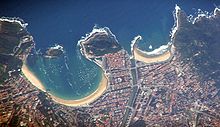



Abay is a recessed, coastal body of water that directly connects to a larger main body of water, such as an ocean, a lake, or another bay.[1][2][3] A large bay is usually called a gulf, sea, sound, or bight. A cove is a small, circular bay with a narrow entrance. A fjord is an elongated bay formed by glacial action.[4] The term embayment is also used for related features, such as extinct bays or freshwater environments.
A bay can be the estuary of a river, such as the Chesapeake Bay, an estuary of the Susquehanna River.[2] Bays may also be nested within each other; for example, James Bay is an arm of Hudson Bayinnortheastern Canada. Some large bays, such as the Bay of Bengal and Hudson Bay, have varied marine geology.[citation needed]
The land surrounding a bay often reduces the strength of winds and blocks waves. Bays may have as wide a variety of shoreline characteristics as other shorelines. In some cases, bays have beaches, which "are usually characterized by a steep upper foreshore with a broad, flat fronting terrace".[5] Bays were significant in the history of human settlement because they provided easy access to marine resources like fisheries.[6] Later they were important in the development of sea trade as the safe anchorage they provide encouraged their selection as ports.[7]
The United Nations Convention on the Law of the Sea defines a bay as a well-marked indentation in the coastline, whose penetration is in such proportion to the width of its mouth as to contain land-locked waters and constitute more than a mere curvature of the coast. An indentation, however, shall not be regarded as a bay unless its area is as large as (or larger than) that of the semi-circle whose diameter is a line drawn across the mouth of that indentation — otherwise it would be referred to as a bight.[8][a]


There are various ways in which bays can form. The largest bays have developed through plate tectonics.[7] As the super-continent Pangaea broke up along curved and indented fault lines, the continents moved apart and left large bays; these include the Gulf of Guinea, the Gulf of Mexico, and the Bay of Bengal, which is the world's largest bay.[7]
Bays also form through coastal erosion by rivers and glaciers.[7] A bay formed by a glacier is a fjord. Rias are created by rivers and are characterised by more gradual slopes. Deposits of softer rocks erode more rapidly, forming bays, while harder rocks erode less quickly, leaving headlands.
| National |
|
|---|---|
| Other |
|